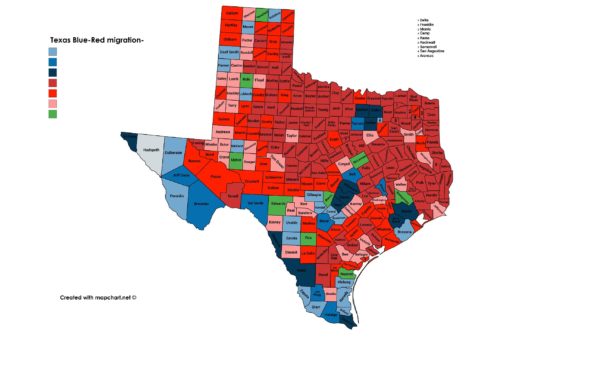Exclusive to LifeZette, a respected conservative DC Democrat political analyst recently conducted a regression study that looked at voting trends in key states. He gave us permission to quote him, but only anonymously, as he is concerned over fellow Democrat retribution.
In statistical modeling, regression analysis is a set of processes for estimating the relationships between a variable and one or more independent variables. In layman’s terms, it compares one thing to other things by the same standards. You may ask: Why would we trust this Democrat if he is still a Democrat? Long association, the accuracy of his past work, and he is still a Democrat for long term job reasons. He is no fan of the current party.
When the analyst got to Texas he was surprised. Given the unexpected strength of Beto O’Rourke’s campaign for a Texas U.S. Senate seat in 2018, he lost to Ted Cruz only by 50.9% to 48.3% (the closest Texas U.S. Senate race in 40 years), it was possible the state was trending more blue. But as this study shows, not just blue, but possibly blue enough to affect this year’s presidential race, though perhaps not enough to tip it to the Democrats. Perhaps.
However, this report only looks at 2000-2016. Before Beto and before the virus. If things have changed for the worse for the GOP since then the party could be looking at a real barn burner in the Lone Star State. And if the GOP loses Texas it does not have the electoral college strength to make up for it anywhere else and Joe Biden will be elected president. As such, this study shows disturbing trends.
“This map shows the strength of the shifts inside TX 2000-2106. Geographically, the state is veering sharply right. The redder the county, the more the veer toward the GOP. The bluer the county, the more the veer toward the Democrats. No problem there I suspect, pretty common over the country. Texas as a whole is not shifting leftward, only a few counties are. Otherwise TX is splitting like an overripe watermelon with large areas of the state simply breaking away from other large areas.

When you do a regression analysis, though, the problems for the Republicans become apparent immediately. The more rural the area, the stronger the shift toward the GOP. That automatically means that the smaller counties (or the shrinking counties) are the ones becoming redder. On the flip side, as everywhere, the urban areas are going blue. But the issue is that the regression analysis holds true there too. The faster a place is growing, the stronger the trend is towards the blue. I expected so-called ‘boom towns’ to be going GOP or at least being somewhat neutral in trend because of the entrepreneurship factor. Not at all, ‘boom towns’ are going Democrat faster than other places.
So the places that are losing population, hence voters, are the backbone of the GOP in Texas. This may not be startling, but it may be fatal. The places that are gaining population, hence voters, are the backbone of the Democrat party. Again, not startling, but quite possibly fatal. The real driver of division is the smaller areas loathe the larger and the larger disdain the smaller. Policies are not so much issue but, prima facie, evidence as to the other side’s evil.
The Trump phenomena vastly accelerated these trends. The smaller the place (or the more it is falling behind in voter numbers), the bigger the shift toward Trump. This is usually of considerable size in terms of percent. The larger the place, or the more quickly it is growing, the bigger the shift against Trump.
This means, paradoxically, that the more successful Trump is, the more votes he loses where votes actually count. Kavanaugh was a disaster for the GOP in a sense of ideological division, fracking has been a Pyrrhic victory, even one of the greatest economic booms in US history made things worse in terms of voting, not better, since, I suspect, it raised the ire of those who see deregulation as an indicator of the acceptance of evil (Clean Water Act) and those who chant about ‘tax breaks for the rich’.
Trump must turn out more voters more or less just to stay where he is. So if he is an activist candidate, he loses votes since an activist Republican deepens the divide that loses GOP votes. If he is stay-at-home candidate he will not turn out his base. But the time frame is open. The GOP is in a real bind. Victories, i.e., Kavanaugh, translate into defeats because they can be used to demonize the GOP in the key areas. So I am not calling TX for the Democrats this time, but the trends are toxic.”

Join the Discussion
COMMENTS POLICY: We have no tolerance for messages of violence, racism, vulgarity, obscenity or other such discourteous behavior. Thank you for contributing to a respectful and useful online dialogue.